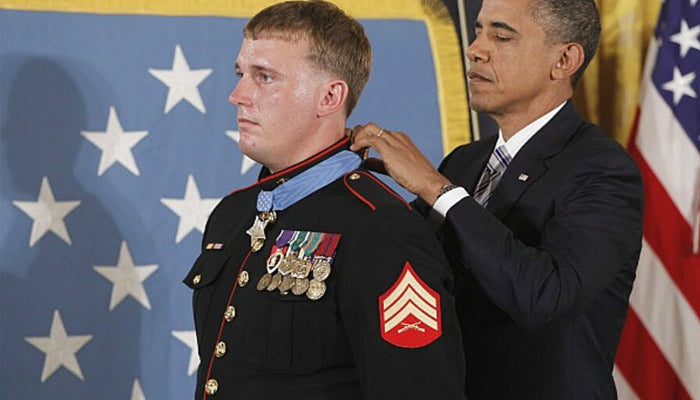In the tapestry of American history, there are certain symbols that stand out as enduring reminders of our nation's values and the sacrifices made by those who defend them. Among these cherished emblems is the POW/MIA flag, a powerful representation of our unwavering commitment to the men and women who have endured captivity or vanished while serving our country. This stark black and white banner, born from the ashes of the Vietnam War, continues to fly high, whispering a promise to the families of the missing: "You are not forgotten."
The Birth Of An Icon Flag:
The story of the POW/MIA flag begins in the tumultuous years of the Vietnam War, a conflict that left an indelible scar on the American psyche. As the war raged on, thousands of U.S. service members found themselves in the clutches of the enemy, taken prisoner, or vanishing without a trace. The families of these brave souls were left to grapple with the unimaginable pain of not knowing the fate of their loved ones.
It was during this time that Mary Hoff, the wife of a missing service member, decided to take action. She approached Annin & Company, a well-known flag manufacturer, with a heartfelt request: to create a flag that would honor the sacrifices of POWs and MIAs. Norman Rivkees, the company's Vice President of Sales, took on the challenge, and together with Mary, they set out to design a symbol that would capture the nation's resolve to bring our heroes home.
The Beacon of Hope:
The resulting design was a testament to the power of simplicity. Against a stark white background, a silhouette of a man's head stands out in bold relief, flanked by the letters "POW" and "MIA." Below, the phrase "You Are Not Forgotten" serves as a poignant reminder of the nation's commitment to those who have sacrificed so much. The black and white colors of the flag hold a deeper meaning, symbolizing the bleak conditions endured by prisoners and the unwavering hope for their safe return.
As the flag began to make its way into the public consciousness, it quickly gained traction among those who understood its profound significance. The National League of POW/MIA Families, an organization founded by the wives of missing service members, recognized the flag's potential as a rallying point for their cause. In 1972, they adopted it as their official symbol, setting the stage for its eventual rise to national prominence.
Gaining National Recognition:
The tireless efforts of the National League of POW/MIA Families to raise awareness about the plight of POWs and MIAs did not go unnoticed. As the flag's visibility increased, so too did the nation's understanding of the sacrifices made by these brave individuals. Slowly but surely, the POW/MIA flag began to take its place among the most revered symbols of American patriotism.
A major turning point came in 1989, when Congress passed Public Law 101-355. This landmark legislation officially recognized the POW/MIA flag as a symbol of the nation's commitment to resolving the fates of Americans still prisoner, missing, or unaccounted for in Southeast Asia. The law mandated that the flag be displayed at specific locations, including the White House, the U.S. Capitol, and the Vietnam Veterans Memorial, on certain days throughout the year.
Flying High Across The Land:
Today, the POW/MIA flag is a ubiquitous sight across the United States. It flies high above military installations, government buildings, and veterans' organizations, serving as a constant reminder of the sacrifices made by our nation's heroes. Its presence at high-profile events, such as National Football League games, ensures that the stories of our missing service members remain at the forefront of the public consciousness.
The flag's popularity has also inspired other initiatives aimed at honoring POWs and MIAs. One such example is the "POW/MIA Forever Stamp," introduced by the U.S. Postal Service. The stamp, which features the iconic black and white design of the POW/MIA flag, serves not only as a tribute to those who have served but also as a means to support efforts to account for missing personnel and provide assistance to their families.
Keeping the Promise:
As we reflect on the history and significance of the POW/MIA flag, we are reminded of the immense sacrifices made by those who have served our country. This simple yet powerful symbol has come to represent the resilience, hope, and commitment of a nation that refuses to forget its heroes. It stands as a testament to the unbreakable bonds that unite us as Americans, transcending differences in race, religion, and political affiliation.
The POW/MIA flag is more than just a piece of cloth; it is a promise. It is a promise to the families of the missing that their loved ones will never be forgotten. It is a promise to those who have endured the horrors of captivity that their sacrifice will not be in vain. And it is a promise to future generations that we will always honor the courage and dedication of those who have served.
In the immortal words of former President Ronald Reagan, "We will never forget our missing in action heroes, and we will not stop searching until we have accounted for every last one of them." As long as the POW/MIA flag continues to fly, this solemn promise will endure. Let us all pledge to keep this promise alive, not only in our words but in our actions. For it is only through our collective resolve that we can hope to bring closure to the families of the missing and honor the memory of those who have given so much for our country.







